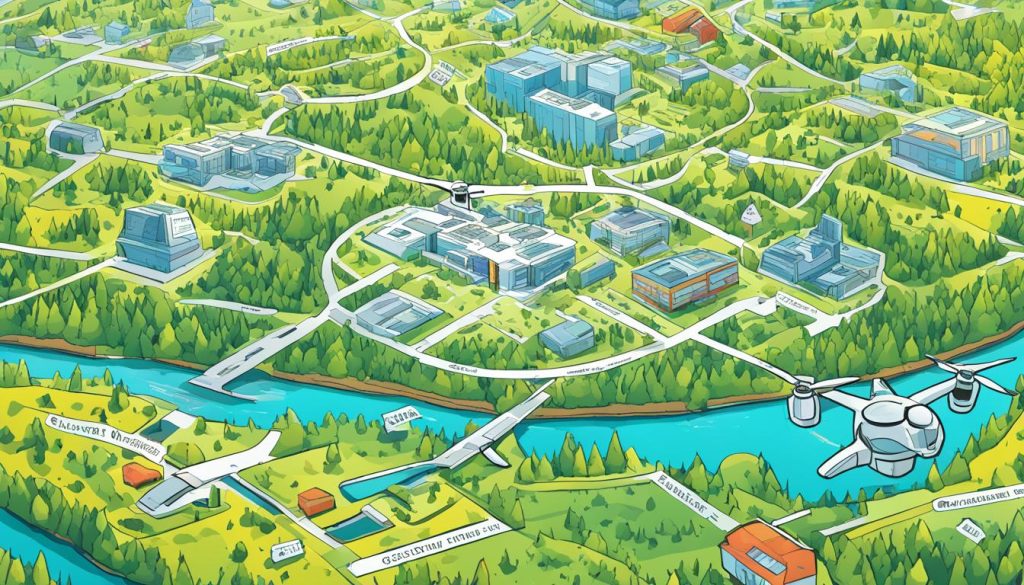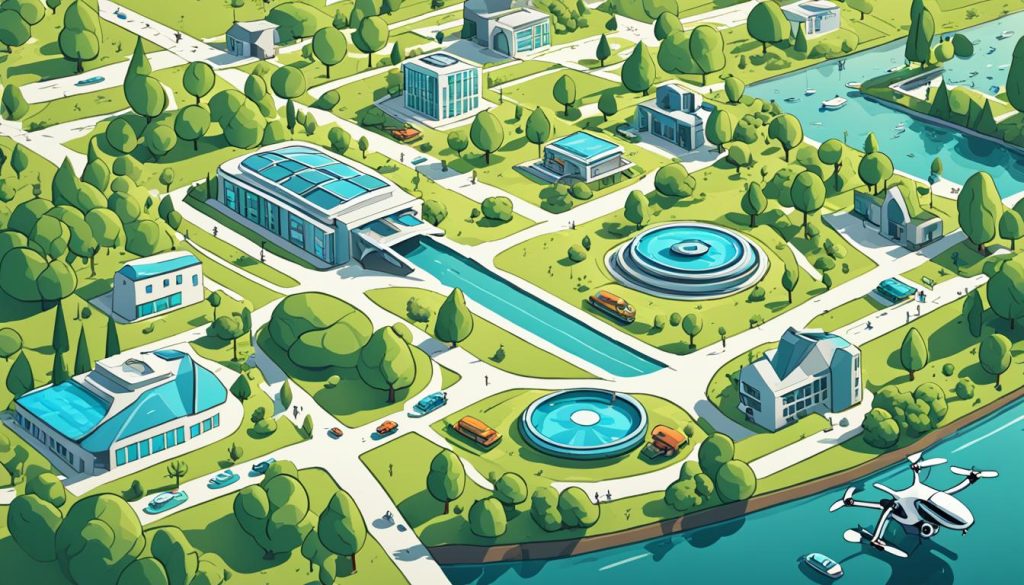Enhance your drone photography with AI scene recognition. This tech analyzes your aerial shots in real-time. It helps you get stunning photos easily. By using computer vision and image analysis, you open up new creative ways and make your work easier.
AI scene recognition changes how you take aerial photos. It’s like having a smart helper that spots objects, landscapes, and the best shooting times. This tech gets better over time, getting better at recognizing and sorting what’s in your view.
Adding AI scene recognition to your drone photography tools gives you an edge. It helps you find unique shots, change camera settings quickly, and catch moments you might miss. Get ready to elevate your aerial photos with AI’s power.
Understanding AI Scene Recognition in Drone Photography
AI scene recognition is changing drone photography. It uses computer vision algorithms to look at and understand aerial images. This makes your aerial photos better and faster. Let’s explore how it works and its benefits for drone users and pros.
What is AI Scene Recognition?
AI scene recognition is a new tech that uses image classification to spot and group things in aerial photos. It analyzes visual data with complex algorithms. This lets drones see and understand their surroundings as they fly.
How AI Scene Recognition Works in Drones
Drones with AI scene recognition have advanced object detection systems. These systems learn from huge amounts of aerial photos. They can spot different things like buildings, land features, and specific objects like solar panels or crops.
| Step | Process |
|---|---|
| 1 | Image capture by drone camera |
| 2 | Real-time processing using onboard AI |
| 3 | Scene analysis and element identification |
| 4 | Adjustment of camera settings or flight path |
Benefits of AI Scene Recognition for Aerial Photography
AI scene recognition has many benefits for drone photographers:
- Automated camera settings adjustment for the best shot
- Better composition and framing tips
- Improved post-processing tools
- Quick image tagging and sorting
These features make taking amazing aerial photos easier and more precise. It opens up new possibilities in fields like farming, building, and emergency services.
The Evolution of AI in Photography
AI has changed photography a lot, making how we take and edit photos better. It started with simple facial recognition and now includes advanced features like eye and animal detection. These have greatly improved how we take photos.
Facial recognition used to be just for security, but now it’s key in camera autofocus. It quickly finds and focuses on people’s faces, making portraits sharp.
Eye detection is an upgrade to facial recognition. It makes sure the eyes are always sharp. This is great for portrait photographers, making shots more engaging.
Wildlife photographers love animal detection AI. It spots different animals, helping track and focus on them in the wild. This is super useful for capturing quick or hard-to-see animals.
Environment recognition is another big change. Smartphones use it to understand scenes and adjust settings on their own. For example, Apple’s Portrait mode uses AI to spot objects and create a shallow depth of field, like a DSLR camera.
These AI tools have made photography easier for everyone, from beginners to pros. As technology gets better, we’ll see more cool uses of AI in photography.
Key Components of AI Scene Recognition Systems
AI scene recognition systems are changing drone photography. They use advanced tech to understand aerial images. Let’s look at what makes this possible.
Computer Vision Algorithms
Computer vision algorithms are key to AI scene recognition. They take raw image data and find features and patterns. This lets drones see and understand what’s around them, just like humans do.
Machine Learning Models
Deep learning models are central to AI scene recognition. They learn from huge datasets to spot complex image patterns. Convolutional neural networks are great at analyzing images.
Image Classification Techniques
Image classification is vital for scene recognition. It puts images into groups. Techniques like image segmentation break aerial photos into parts for closer analysis.
| Component | Function | Example |
|---|---|---|
| Computer Vision Algorithms | Process raw image data | Edge detection, feature extraction |
| Deep Learning Models | Recognize patterns and features | Convolutional neural networks |
| Image Classification | Categorize images | Object recognition, scene labeling |
These parts work together in AI scene recognition systems. They help drones take amazing aerial photos and give insights about the environment. As tech gets better, we’ll see more advanced AI tools for drone photography.
How to Use AI Scene Recognition to Improve Drone Photography
AI scene recognition is changing drone photography for the better. It gives you tools to make your aerial shots better. With this tech, you can take your drone photos to the next level.

Real-time recognition lets your drone check the scene as you move. It makes quick changes to get the perfect shot. This tech spots important parts in your shot and changes camera settings to match.
One big plus of AI scene recognition is automated settings. Your drone can change settings for different lights, adjust exposure, and focus on its own. This lets you focus more on how you want your shot to look.
Composition help is another big change. AI gives you tips on framing based on what it sees in the scene. This is super useful in places you’re not familiar with or when things are tricky.
| AI Feature | Benefit |
|---|---|
| Real-time recognition | Instant scene analysis and optimization |
| Automated settings adjustment | Adaptive exposure and focus control |
| Composition assistance | AI-powered framing suggestions |
To get the best from AI scene recognition, learn what your drone can do. Try out different modes and settings to see what suits you. Remember, AI is here to help your creativity, not take over.
Implementing AI Scene Recognition in Your Drone Setup
Adding AI scene recognition to your drone can boost your aerial photography skills. This tech lets your drone automatically adjust to different scenes. It makes your photos better in quality and how they look.
Compatible Drone Models and Software
Many drones today have AI built-in. Models like the DJI Mavic 3 and Skydio 2+ come with AI features. If your drone is older, you might need to add special software for AI. Some good choices are:
- DJI Go 4
- Litchi
- Pix4D
Setting Up AI Scene Recognition Features
To use AI scene recognition on your drone:
- Update your drone’s firmware to the latest version
- Install the needed drone software on your mobile device
- Turn on AI features in your drone’s settings
- Calibrate your drone’s camera for the best results
Optimizing Settings for Best Results
Adjust your drone’s AI settings for top image processing:
- Change object detection sensitivity
- Set the right exposure settings
- Pick the correct color profile for your scene
Practice with different settings to find what works best for you. With the right setup and tweaks, AI scene recognition can elevate your drone photos.
AI-Powered Composition Techniques for Drone Photography

AI technology is changing drone photography by making aerial shots better. With AI, you can take amazing photos that were hard to get before. These smart tools look at scenes and suggest the best framing and settings for your shots.
Dynamic framing is a big part of AI in drone photography. It spots things in your scene and suggests the best ways to take pictures. It helps you place your drone for shots that look great, whether it’s landscapes, buildings, or events from above.
AI helps with tricky shots like panoramas, time-lapses, and following moving things. These modes use smart algorithms for smooth camera moves and the right exposure. This makes your videos look professional.
- Rule of thirds application for balanced compositions
- Leading lines detection to guide viewers’ eyes
- Pattern recognition for visually striking aerial shots
- Golden ratio alignment for aesthetically pleasing images
Using AI in your drone photography opens up new creative ways to shoot. It’s like having a virtual assistant that helps with framing, focus, and capturing moments. As you try these tools, you’ll find new ways to improve your drone photos.
Enhancing Post-Processing with AI Scene Recognition Data
AI scene recognition data is changing drone photography post-processing. It makes editing easier and leads to amazing results. Let’s see how AI improves image editing.
Leveraging Scene Information for Editing
AI photo editing tools look at scene details to offer the best adjustments. This cuts down editing time and boosts accuracy. You can adjust things like exposure, contrast, and color balance for different scenes like landscapes or water.
AI-Assisted Color Grading and Tone Mapping
AI-powered software is great at color grading and tone mapping. It can make colors pop and adjust tones for eye-catching images. This automated editing keeps your drone photos consistent but still lets you be creative.
Automated Image Tagging and Organization
AI scene recognition makes managing your drone photos easy by tagging and organizing them automatically. Your photos get sorted by recognized elements, making it simple to find specific shots later.
| AI Feature | Benefit | Example Tool |
|---|---|---|
| Scene Analysis | Tailored editing suggestions | Adobe Firefly |
| Color Grading | Enhanced visual appeal | Luminar Neo |
| Auto-tagging | Efficient image organization | Google Photos |
Using AI scene recognition in your editing workflow gets you pro-level results with less work. Just remember to mix AI help with your creative ideas for unique drone shots.
Overcoming Challenges in AI Scene Recognition for Drones
AI scene recognition in drone photography has its own set of challenges. The way objects look from above is different from what we see on the ground. This makes it hard to spot objects clearly. Also, the big size of aerial images makes processing the data tough.
To solve these problems, we need special techniques. For example, cropping images at different sizes and angles can make objects stand out more. Using a sliding window method helps find small objects that blend in with the background.
Getting the data right is also a big challenge. Drone images need careful labeling to train AI models well. This takes a lot of time but is crucial for better accuracy.
| Challenge | Solution |
|---|---|
| Small object detection | Multi-scale image processing |
| Flat object appearance | Angle-specific training data |
| Large image sizes | Efficient data compression techniques |
| Object overlap | Advanced segmentation algorithms |
Improving AI models is vital to beat these aerial image challenges. By making algorithms better and adding more training data, drone photographers can look forward to more precise scene recognition.
Future Trends in AI-Powered Drone Photography
The world of drone photography is changing fast, with AI at the forefront. As AI in drones advances, we’ll see big changes in how we take and make aerial pictures.
Advancements in Real-Time Recognition
Real-time recognition is going to change drone photography. Soon, drones will quickly analyze scenes and adjust camera settings automatically. This means you’ll get perfect shots without needing to adjust settings yourself, even in tough lighting.
Integration with Autonomous Flight Systems
Autonomous drones are coming, offering hands-free flying. These drones will move through complex places, avoid things, and set up shots on their own. You can then focus on the creative side while the drone takes care of flying and photography.
AI-Generated Creative Suggestions
Creative AI will soon be your go-to artistic helper. Your drone’s AI will look at scenes and suggest new ways to take pictures, angles, and shots you might not think of. This mix of human creativity and AI will open up new ways to take aerial photos, helping you explore new artistic ideas.






